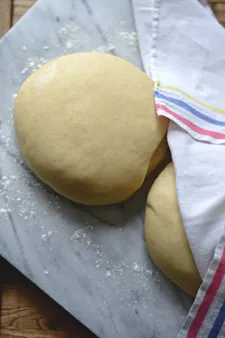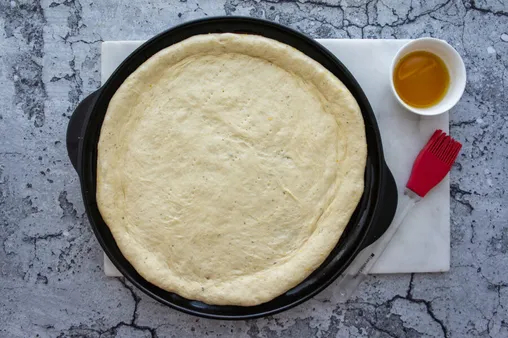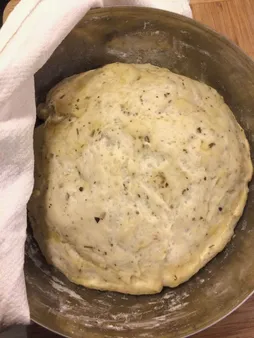Table of Contents
Getting a crispy, delicious pizza crust is all about hitting that perfect temperature for cooking pizza dough. Whether you are a seasoned pizzaiolo or a weekend baker, understanding how oven temperature affects your pizza dough can elevate your pizza game. This comprehensive guide from tauhuichiban will explore the ideal temperatures for various ovens and provide expert tips for baking pizza like a pro.
Oven Type | Temperature (°F) | Temperature (°C) | Notes |
|---|---|---|---|
Home Oven | 500 - 550 | 260-290 | Preheat thoroughly with a pizza stone or steel for best results. |
Pizza Oven | 750 - 900+ | 400 - 480+ | High heat creates a crispy crust with a slight char. |
Convection Oven | Reduce temperature by 25°F from standard recipe | Reduce temperature by 15°C from standard recipe | Fan circulation cooks food more quickly and evenly. |

Unlock The Secret: Perfect Temperature For Cooking Pizza Dough
Understanding Pizza Dough and Oven Temperature
What Makes Pizza Dough Tick?
Pizza dough is a delicate balance of ingredients, and its success relies heavily on the harmony between yeast, flour, water, salt, and sugar. Yeast fermentation is the magic that makes dough rise, giving pizza its signature crust. But did you know that temperature plays a crucial role in this process?
When yeast ferments, it produces carbon dioxide gas, causing the dough to expand. However, if the temperature is too low, fermentation slows down, and if it's too high, yeast dies. The ideal temperature for yeast fermentation is between 75°F and 80°F (24°C to 27°C). This is why a warm, draft-free place is perfect for letting the dough rise.
Ingredient | Role in Dough |
|---|---|
Yeast | Fermentation, rising |
Flour | Structure, texture |
Water | Hydration, yeast activation |
Salt | Flavor, yeast control |
Sugar | Yeast food, browning |
Oven Temperature: The Final Frontier
Now that we've discussed the intricacies of pizza dough, it's time to talk about the oven temperature. The ideal temperature for cooking pizza dough depends on the type of oven you're using. For a conventional home oven, 500°F to 550°F (260°C to 290°C) is the sweet spot. This high heat produces a crispy crust, while lower temperatures can result in a soggy or undercooked base.
But what about pizza ovens? These specialized ovens can reach temperatures of 900°F (480°C) or more, producing a crust that's crispy on the outside and tender on the inside. The extreme heat also allows for a quick cooking time, which helps retain the toppings' flavors and textures.

Understanding Pizza Dough and Oven Temperature
Finding the Sweet Spot: Temperature for Cooking Pizza Dough in Different Ovens
Home Oven Heroics
So, you're ready to conquer the pizza game at home, right? Your regular oven is a trusty sidekick, but it needs a little guidance to achieve pizza perfection. Aim for that 500°F to 550°F (260°C to 290°C) range – think of it as giving your oven superpowers! Now, here's a secret: preheating is key. It's like warming up the oven's muscles for a pizza-baking marathon. Pop in a pizza stone or steel while it's preheating – they're like heat magnets, giving your crust that irresistible crispy texture.
Unleashing the Pizza Oven Powerhouse
Ever wondered how pizzerias get those perfectly charred, bubbly crusts? Well, their secret weapon is a supercharged pizza oven! These bad boys can hit temperatures of 900°F (480°C) or higher – imagine a dragon's breath, but for pizza! The intense heat creates a crust that's crispy on the outside and chewy on the inside, all in a blink of an eye. It's like magic, but with more cheese!
Oven Type | Temperature (°F) | Temperature (°C) |
|---|---|---|
Home Oven (Conventional or Convection) | 500-550°F | 260-290°C |
Pizza Oven | 750-900°F + | 400-480°C + |

Finding the Sweet Spot: Temperature for Cooking Pizza Dough in Different Ovens
Tips and Tricks for Perfect Pizza Crust Every Time
Embrace the Power of Steam
Want to know a secret for an extra-airy crust? Steam is your new best friend! Imagine those little pockets of air in your crust – steam helps create them, making it light and fluffy. You can create a steamy oven environment by placing a heatproof pan of water on the bottom rack while your pizza bakes. Or, try spritzing the oven walls with water a few times during baking. It's like giving your pizza a spa treatment!
Don't Be Afraid to Experiment
Remember, baking is all about having fun and experimenting! Don't be afraid to tweak the temperature or cooking time slightly to find what works best for your oven and dough. Every oven has its own personality, so get to know yours! You can even try different types of flour for unique flavors and textures. The possibilities are endless, so get creative and enjoy the delicious journey!
Problem | Possible Solution |
|---|---|
Pizza crust is too pale | Increase oven temperature slightly, bake for a few more minutes, or move pizza to a lower oven rack for direct heat. |
Pizza crust is burnt on the bottom | Lower oven temperature, bake on a higher oven rack, or preheat pizza stone or steel for longer. |
Pizza crust is soggy in the center | Preheat oven thoroughly, use less sauce, or make sure toppings aren't overly wet. |

Tips and Tricks for Perfect Pizza Crust Every Time
Final Thought
Mastering the art of pizza making is a journey, and understanding the importance of the correct temperature for cooking pizza dough is a crucial step. By following these guidelines, experimenting with your oven, and embracing the tips we've shared, you'll be well on your way to creating pizzeria-quality pizzas in the comfort of your own home. So fire up your oven, embrace the delicious possibilities, and enjoy the irresistible aroma and taste of perfectly cooked pizza!